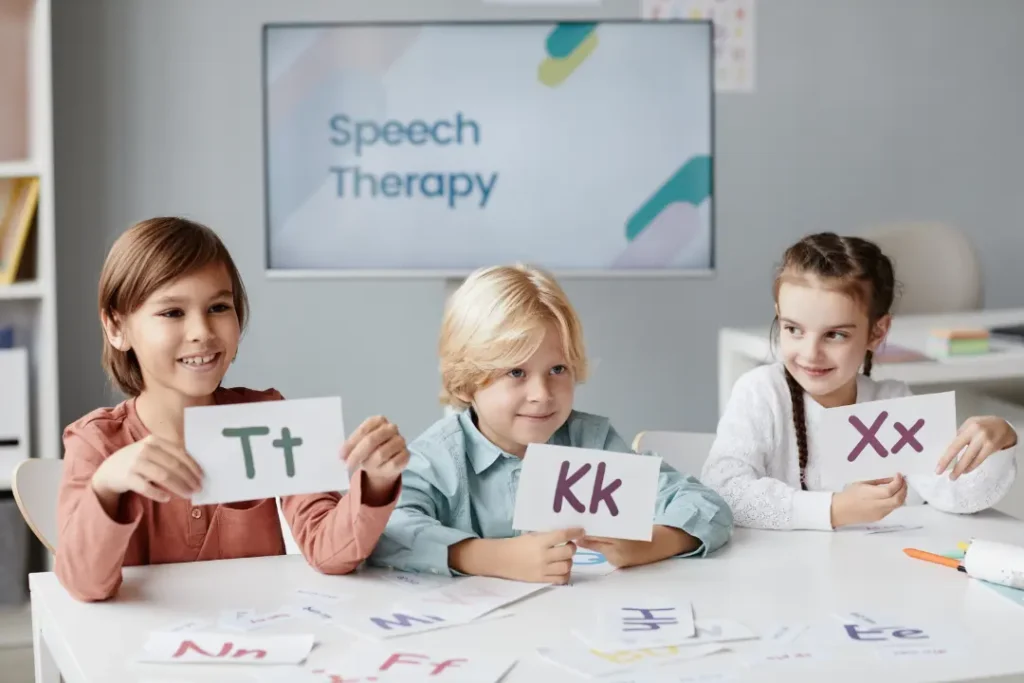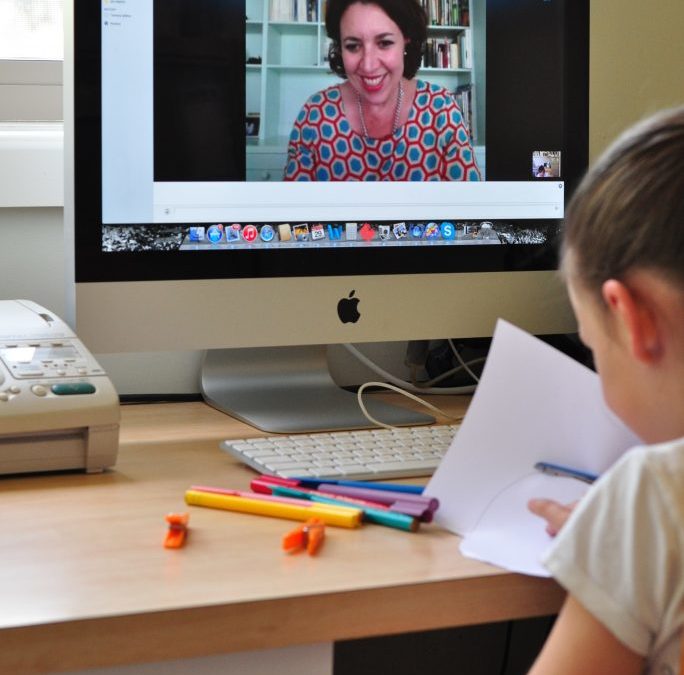Looking for effective speech and language tools? This article highlights the top tools for supporting speech and language development. Discover apps, games, and more for effective therapy.
Key Takeaways
- Speech and language tools, such as Word FLIPS and flashcards, help children with communication difficulties enhance their vocabulary and comprehension skills.
- Therapy Connect is an NDIS-registered online allied health provider, delivering accessible speech therapy for people all over Australia.
- Integrating technology in speech therapy, such as apps, enhances engagement and allows for personalised learning and can improve outcomes for children.
Essential Speech and Language Tools for Children
Children with communication difficulties benefit from tools designed specifically for aiding and developing speech and language skills. For example, Word FLIPS toys help children learn functional vocabulary through real words and pictures, providing visual and auditory cues that reinforce language learning.
Flashcard sets like ‘Feelings and Emotions’ and ‘Verbs’ use visual aids to encourage communication and aid in language development. Associating words with images through flashcards can enhance vocabulary and comprehension.
Speech therapy tools include many language resources to enhance communication skills. These resources support children’s language development by allowing them to express themselves more effectively, improving speech sounds, and fostering social skills related to speech disorders and speech pathology.

Online Therapy Services by Therapy Connect
Therapy Connect makes speech therapy more accessible to people in remote and rural locations by offering online therapy services. Our team of speech pathologists are all highly experienced and this means more people can access high quality care, no matter where they are located in Australia.
Therapy Connect services are covered for National Disability Insurance Scheme (NDIS) participants. Therapy Connect ensures children and adolescents with autism and developmental delays receive tailored, evidence-based online therapy services. This approach allows even those with complex needs to benefit from professional support.
Benefits of Using Speech and Language Tools at Home
Using speech and language tools at home provides numerous benefits for a child’s communication development. Regular practice at home reinforces learning from therapy sessions, leading to better outcomes and helping children apply new skills in everyday situations.
Reading stories together supports language development and strengthens the bond between adults and children. Picture books introduce children to diverse cultures and ideas, exploring emotions and aiding in developing empathy and social understanding to support children.
Customisable apps allow parents to tailor therapeutic activities to their child’s specific communication goals and skill levels. These apps can be adjusted to focus on particular speech sounds, childhood apraxia, or language skills, providing targeted support.
Various speech and language tools, including speech therapy toys, board games, and flashcards, ensure parents have multiple options to support their child’s communication development at home.
Evidence-Based Resources for Speech Therapists
Speech therapists use evidence-based resources to ensure effective interventions. Curated by qualified professionals, these resources support speech and language development in children and adolescents and are backed by current research to ensure treatment efficacy.
Modern speech therapy technology enables better progress tracking and allows therapists to adjust treatment plans based on real-time data. Apps help real-time feedback parents monitor progress and adjust learning activities, enhancing the therapeutic process and empowering parents to take an active role.
Group discussions and journaling with prompts are effective strategies for developing communication skills. These activities encourage natural language use and fluency in a supportive environment. Additionally, Therapy Connect offers fully funded therapy services for NDIS participants, eliminating out-of-pocket costs.
You might also be interested in reading our 10 Fun Skill-Building Activities To Try at Home!
Interactive Games and Activities for Speech Development
Interactive games and activities are an engaging and effective way to enhance speech development in children. Speech therapy apps offer activities that motivate children to participate in their therapy, providing a range of interactive games and resources for ongoing therapy outside of traditional sessions.
Board games and flashcards are valuable tools for improving speech skills and phonological awareness. Games focusing on specific sounds help children improve pronunciation by using targeted words in sentences. Activities like hopscotch with target words enhance pronunciation and engage children physically, making learning more dynamic.
Physical activities like alphabet scavenger hunts or burying objects in sand support speech development by encouraging children to name and use words in context, enhancing pronunciation and fluency. Games like ‘I Spy’ and ‘Heads Up!’ improve turn-taking and sentence fluency, making speech practice enjoyable and interactive.
Picture Books and Storytelling for Language Skills
Picture books and storytelling are effective tools for developing language skills in children. Engaging with picture books enhances vocabulary and literacy skills through straightforward and repetitive language. These books often feature rhythm and rhyme, which are essential for fostering phonological awareness in young learners.
Storytelling supports language development by helping children understand story structure, such as beginning, middle, and end. This understanding aids comprehension and encourages the use of more complex sentences. Listening to stories exposes children to new words and phrases in context, which helps incorporate them into their vocabulary.
Picture books and storytelling are particularly beneficial for children with dyslexia or other learning difficulties. These stories’ visual and auditory elements provide multiple ways for children to engage with the material, aiding in understanding and remembering new words and concepts.

The Role of Technology in Speech Therapy
Technology has transformed speech therapy, making it more accessible and effective. Using technology for speech therapy at home provides families with tools to continue therapeutic practices outside professional sessions. Apps like Articulation Station offer multiple levels of practice, helping children improve articulation and sentence formation in a structured yet engaging way.
Augmented and virtual reality technologies create immersive environments that enhance engagement in speech therapy exercises. These technologies allow children to practice speech in realistic scenarios, making learning more relevant and enjoyable.
Speech recognition software enhances therapy by providing real-time feedback and personalised exercises to improve articulation and language skills. Integrating these technologies into speech therapy makes it more engaging for children. It provides valuable data for therapists, who can use it to track progress and adjust treatment plans for effective support.
How to Choose the Right Speech and Language Tools
Choosing the right speech and language tools requires understanding the child’s or client’s specific needs. Consider their strengths, weaknesses, and individual goals. Balancing cost and accessibility is crucial for effective therapy delivery.

Researching companies that provide speech therapy materials and reviewing their products will help in making informed choices. Look for evidence-based materials proven effective in supporting speech and language development. Consulting with experienced speech-language pathologists provides valuable insights into the effectiveness of different materials.
Choosing engaging and appropriate tools for the client’s age and developmental level is also essential. Selecting the right toys, apps, or other resources can significantly impact the success of speech and language therapy.
Summary
In summary, speech and language tools play a crucial role in supporting effective communication development. From specialised toys and flashcards to online therapy services and interactive games, there are numerous resources available to help children improve their communication skills. The benefits of using these tools at home, combined with the support of professional speech therapists, can lead to significant improvements in speech and language development.
As technology advances, the speech therapy field will only become more accessible and effective. Parents and therapists can provide the best possible support for children with communication difficulties by choosing the right tools and staying informed about the latest developments. Let’s embrace these resources and work together to help every child reach their full potential.
Frequently Asked Questions
What are some essential speech and language tools for children?
Essential tools for children include Word FLIPS toys; flashcard sets focusing on ‘Feelings and Emotions,’ and other speech therapy resources that promote effective communication skills. These tools play a crucial role in developing language abilities.
How does Therapy Connect provide online therapy services?
Therapy Connect provides online therapy services through video conferencing tools, ensuring accessibility for children and adolescents, particularly those in rural areas. This approach effectively bridges the gap for those in need of therapeutic support.
What are the benefits of using speech and language tools at home?
Using speech and language tools at home enhances consistency in practice and fosters bonding through shared reading experiences. It also allows for customisation to meet specific communication goals, maximising the effectiveness of therapy.
How can speech therapists ensure they are using effective resources?
To ensure effective resource usage, speech therapists should rely on evidence-based practices, use technology to monitor progress, and actively participate in collaborative discussions. This approach enhances their effectiveness and improves client outcomes.
What should I consider when choosing speech and language tools?
When choosing speech and language tools, prioritise the client’s specific needs, evaluate the cost and accessibility of materials, and consult with experienced speech-language pathologists to ensure effectiveness.



